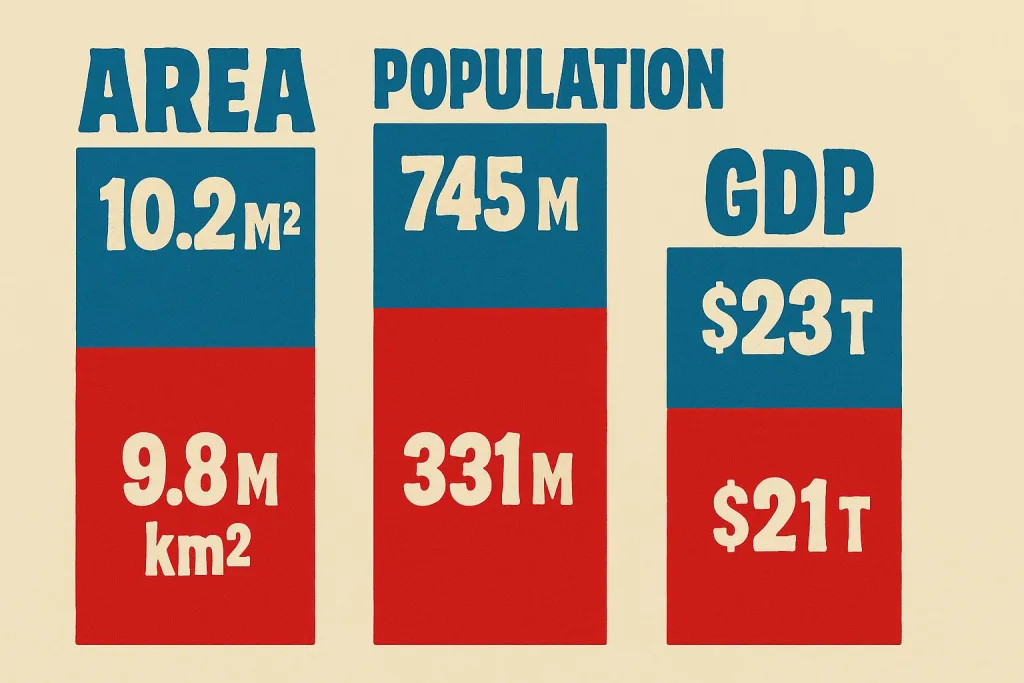Is the US Bigger Than Europe? Detailed Comparison
Many people wonder Is the US Bigger Than Europe in size. The answer depends on what we mean by “bigger.” We can look at land area, population, and economy. In some ways the U.S. is larger, while in others Europe is larger.
Below, we break down each aspect in simple terms and answer common questions, including whether adding Alaska changes things, how Europe compares without Russia, and how the U.S. stacks up against Western Europe and the European Union.
Is the US Bigger Than Europe? Land Area: United States vs. Europe
The United States is enormous – about 9.8 million square kilometers (around 3.8 million square miles) in total area. This includes all 50 states (yes, including Alaska). Europe, as a whole continent, covers about 10.2 million square kilometers (around 3.9 million square miles).
That means Europe is slightly larger in area than the U.S. – only by a small margin of a few percent. In other words, even with Alaska included, the United States is just a bit smaller than the entire continent of Europe.
What about the 48 contiguous U.S. states (excluding Alaska)?
The “lower 48” alone covers roughly 8.1 million km² (3.1 million sq mi). Europe’s 10.2 million km² is about 20% bigger than the contiguous U.S. Without Alaska’s huge area, Europe’s lead in size is even larger. Alaska itself adds over 1.7 million km² (663,000 sq mi) to U.S. territory – a significant chunk of land, but not enough to overtake Europe’s total area.
What if we exclude Russia from Europe?
A big part of Europe’s land area comes from Russia’s European portion (the part of Russia west of the Ural Mountains). If we consider “Europe minus Russia,” the remaining countries cover only about 6.0 million km² (approximately 2.3 million sq mi).
Without Russia, Europe’s area is far smaller than the U.S. In fact, the United States would be about 1.6 times larger than that version of Europe. So, yes – the U.S. is much bigger than Europe if you don’t count Russia.
Is the U.S. bigger than Western Europe?
Yes. “Western Europe” usually refers to the group of countries in the western part of Europe (for example, countries like France, Germany, the UK, Italy, Spain, and others in that vicinity). Combined, all of Western Europe covers only a few million square kilometers (roughly in the 2–3 million km² range, depending on which countries you include).
The United States (9.8 million km²) is about 3 to 4 times larger in area than Western Europe’s countries put together. So, the U.S. landmass easily surpasses the size of Western Europe.
How about the European Union vs. the U.S.?
The European Union (EU) is an economic and political union of 27 European countries. The EU’s total area is about 4.2 million km² (around 1.6 million sq mi).
This is less than half the size of the United States. In fact, the U.S. is roughly twice as large as the entire EU in terms of land area. (Even if the UK were still included, the EU would only be about 4.5 million km² – still much smaller than the U.S.)
Visualizing the size: It can be hard to imagine these big numbers, so a simple visual can help. For example, you could place a map of the U.S. over Europe. You’d see that the contiguous U.S. would span from the Atlantic coasts of Spain and France all the way to far eastern Europe.
Alaska alone is almost as large as all of Western Europe. A bar chart could also show the comparison: one bar for land area of the U.S. and another for Europe – the Europe bar would be just a tiny bit taller than the U.S. bar when all countries are included, but much shorter if Russia is excluded.
Is the US Bigger Than Europe – Population Comparison
Being “bigger” can also mean having more people. In terms of population, Europe is larger than the United States by a wide margin:
- Population of Europe (overall): About 740–750 million people live in Europe (the whole continent). This counts all European countries, including Russia’s population west of the Urals.
- Population of the United States: About 330 million people live in the U.S. (The U.S. is the third most populous country in the world, after China and India.)
This means Europe’s population is more than double the U.S. population. In simple terms, for every person in the United States, there are about two people in Europe.
Now, consider some specific scenarios:
- Europe minus Russia: Even if we exclude Russia’s population, the rest of Europe still has around 600 million people. That is almost twice the U.S. population of 330 million. So, with or without Russia, Europe has more people than the United States.
- Western Europe: The countries of Western Europe (like Germany, France, the UK, Spain, Italy, etc.) together have hundreds of millions of people. For example, just a handful of Western European countries – Germany (~83 million), France (~65 million), the UK (~67 million), Italy (~60 million), and Spain (~47 million) – already sum up to over 300 million. Add the other Western European nations and it easily exceeds the U.S. population. So, the U.S. does not have more people than Western Europe; Western Europe’s population is in the same ballpark or higher.
- European Union: The EU’s combined population is about 447–450 million people (as of recent estimates). The EU alone has more people than the United States (about 120 million more). So, if the question is “Is the U.S. bigger than the European Union in population?” – the answer is no. The EU has roughly one-third more inhabitants than the U.S. does.
In summary, when it comes to population, Europe wins out over the U.S. by a significant amount. Europe simply has many more countries and thus more people overall, whereas the U.S. is just one country (albeit a populous one).
Economic Size (GDP) Comparison
Another way to compare size is by economy – typically measured by Gross Domestic Product (GDP), which is the total value of all goods and services produced. This tells us who has the bigger economy or “economic size.”
- United States GDP: The U.S. has the largest national economy in the world. In recent years, the U.S. GDP has been around $21 trillion USD (21 million million dollars) or even higher. As of 2021–2022, it’s grown to over $23 trillion, and in 2023 it was estimated to be around $25 trillion. This makes the U.S. economy #1 globally by country.
- Europe’s GDP (combined): Europe isn’t a single country, but if you add up all European countries’ economies, you get a number in the same ballpark as the U.S., or even larger.
All European countries together (including the EU members, the UK, Switzerland, Russia, etc.) produce roughly $23–$24 trillion in GDP in total, which is comparable to the U.S. figure. In fact, by some estimates, Europe’s combined economy slightly edges out the U.S. – but remember, that’s the sum of about 50 different countries.
- European Union GDP: If we look at the European Union as a whole (27 countries acting somewhat like one economic bloc), its total GDP is around $17 trillion USD (approximately €17 trillion).
This is a bit smaller than the U.S. economy. The U.S. economy is larger than the EU’s economy. Another way to put it: the U.S. produces more economic output in a year than all 27 EU countries combined.
The EU is still a huge economic player (usually ranked 2nd or 3rd in the world if it were considered as one unit), but it doesn’t quite match the U.S. in size after the exit of the UK and given recent growth differences.

Is the U.S. economy bigger than “Europe”?
It depends how you define Europe. By country, the U.S. is bigger than any single European country’s economy by far (for example, the U.S. GDP is more than four times that of Germany, Europe’s largest national economy).
If by “Europe” we mean the whole continent’s combined economy, then the U.S. and Europe are close: Europe as a whole produces a similar total amount of goods and services as the U.S. does.
It’s fair to say they are on par, with Europe collectively around the same level or slightly above. However, since Europe isn’t one country, the U.S. is often considered economically larger than any unified entity Europe has (like the EU).
In short, the United States has a larger economy than the European Union, but Europe’s total economy (all countries combined) is roughly comparable to the U.S.
To put these figures in perspective with a visual idea, imagine a bar chart for GDP: one bar for the U.S. and one bar for Europe’s total. They would be almost the same height, with Europe’s perhaps just a hair taller if every country is included. But if you compare the U.S. bar to an EU bar, the U.S. bar would be noticeably taller, showing the U.S. leads the EU in economic size.
Summary Table of Key Figures
To wrap up the comparison, here is a simple table summarizing the land area, population, and GDP of the United States versus Europe:
| Region | Land Area | Population | Total GDP (Nominal) |
| United States | ~9.8 million km² (3.8 million sq mi) | ~331 million (0.33 billion) | ~$21 trillion (approx.) |
| Europe (entire) | ~10.2 million km² (3.9 million sq mi) | ~745 million (0.75 billion) | ~$23 trillion (approx.) |
| Europe (no Russia) | ~6.0 million km² (2.3 million sq mi) | ~635 million (0.64 billion) | ~$21 trillion (approx.) |
| European Union (EU) | ~4.2 million km² (1.6 million sq mi) | ~450 million (0.45 billion) | ~$17 trillion (approx.) |
Notes: Land area figures include total area (land + inland water). Europe (entire) includes all European countries (including the part of Russia in Europe). Europe (no Russia) excludes Russia entirely. GDP figures are rounded estimates in U.S. dollars for recent years to give a sense of scale rather than exact current values.
Conclusion
So, is the US bigger than Europe? The answer is yes in some ways, and no in others:
- Land area: Europe as a whole is slightly larger than the U.S., but if you exclude Russia, the U.S. is larger than the rest of Europe. The U.S. is also much bigger than just Western Europe or the European Union in area.
- Population: Europe (with or without Russia) has over twice as many people as the United States. The U.S. population is big, but Europe’s is bigger.
- Economy: The United States has the largest single-country economy. It outpaces the European Union’s economy, but Europe’s combined economies together are on a similar scale as the U.S.
In a nutshell, the United States is huge, but Europe’s combined size and numbers are also very large. It’s interesting to see that while the U.S. covers about the same ground as Europe, Europe holds more people, and economically they are both heavyweights with the U.S. slightly ahead of any single European grouping.
Hopefully, this comparison gives a clear answer to the question and helps you understand the different ways we can think about “bigger” when comparing the U.S. and Europe.






